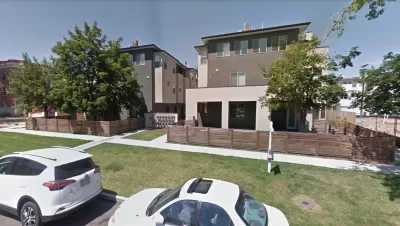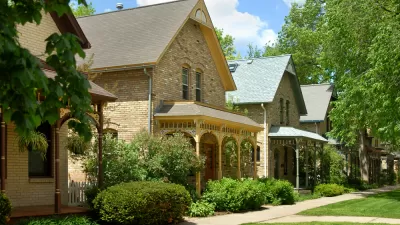Members of the Cleveland Chapter if the American Institute of Architects are raising awareness about the unintended consequences of zoning changes made in 2018 to make it easier to develop townhomes in the city.

Steven Litt reports on increasing political pressure for the city of Cleveland to repeal and revise a section of its zoning code pertaining to townhouses.
The city updated its zoning code in 2018 to streamline the approvals process for townhouses.
"Since then, the city’s Planning Commission has approved more than two dozen townhouse projects primarily in Ohio City and Detroit Shoreway on the West Side, but also in Glenville on the East Side. It’s all part of the mission to rebuild a city that has been losing population and tax base for decades," writes Litt.
A growing chorus of critics includes the Cleveland Chapter of the American Institute of Architects, which says "the 2018 ordinance has weakened the regulation of townhouse design, and the ability of residents to have their say in the approval process," according to Litt. The chapter has submitted a 44-page document asking the city to repeal and replace the townhouse code.
According to the document and from AIA members quoted in the article, developers are abusing the new provisions for townhouses in the city's zoning code. Rather than townhouses resembling the gentle density pursued by the Missing Middle Housing reform movement that is growing in popularity around the country, the architects say the result of the zoning changes in Cleveland has resembled the "slot homes" prohibited in the city of Denver in 2018.
Litt explains in useful detail:
The ground floors of the new townhouses are often dominated by garages and driveways, oriented sideways to the street. The “front doors” of such units are often set along narrow side alleys, or “interior frontages” facing the sides and backyards of adjacent single-family houses.
Even worse are projects configured with parallel rows of townhouses set at right angles to streets, with a central driveway lined with garage doors running down the middle.
To differentiate the results in the city of Cleveland from the desire for Missing Middle Housing, Litt cites Dan Parolek, who coined the term and also wrote the definitive book on the subject. In the article, Parolek cautions against what he calls "tuck under" townhouses—"with garages on the ground floor, built on scattered 'infill' lots in established neighborhoods"—which is what Cleveland has been allowing since the zoning change took effect.
FULL STORY: Critics want Cleveland to replace zoning code allowing controversial, oversized townhouses, ‘slot houses’

Manufactured Crisis: Losing the Nation’s Largest Source of Unsubsidized Affordable Housing
Manufactured housing communities have long been an affordable housing option for millions of people living in the U.S., but that affordability is disappearing rapidly. How did we get here?

Americans May Be Stuck — But Why?
Americans are moving a lot less than they once did, and that is a problem. While Yoni Applebaum, in his highly-publicized article Stuck, gets the reasons badly wrong, it's still important to ask: why are we moving so much less than before?

Research Shows More Roads = More Driving
A national study shows, once again, that increasing road supply induces additional vehicle travel, particularly over the long run.

Judge Halts Enforcement of Anti-Homeless Laws in Grants Pass
The Oregon city will be barred from enforcing two ordinances that prosecute unhoused residents until it increases capacity and accessibility at designated camping sites.

Advancing Sustainability in Los Angeles County Schools
The Los Angeles County Office of Education’s Green Schools Symposium brings together educators, students, and experts to advance sustainability in schools through innovative design, climate resilience strategies, and collaborative learning.

Using Old Oil and Gas Wells for Green Energy Storage
Penn State researchers have found that repurposing abandoned oil and gas wells for geothermal-assisted compressed-air energy storage can boost efficiency, reduce environmental risks, and support clean energy and job transitions.
Urban Design for Planners 1: Software Tools
This six-course series explores essential urban design concepts using open source software and equips planners with the tools they need to participate fully in the urban design process.
Planning for Universal Design
Learn the tools for implementing Universal Design in planning regulations.
City of Moreno Valley
Institute for Housing and Urban Development Studies (IHS)
City of Grandview
Harvard GSD Executive Education
NYU Wagner Graduate School of Public Service
City of Cambridge, Maryland
Newport County Development Council: Connect Greater Newport





























